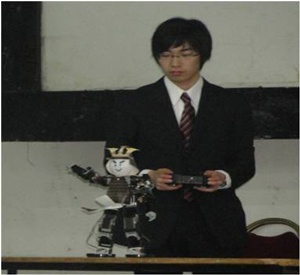Lecture on the Humanoid Robot by Professor Tadakuma Riichiro of Yamagata University
2012/3/19


On March 19, 2012, Professor Tadakuma Riichiro of Yamagata University gave a lecture on the Humanoid Robot at Jomo Kenyatta University of Agriculture and Technology (JKUAT). He was accompanied by Ms. Shiga Ayaka, an administrator at Yamagata University, Mr. Sho Ōwada and Takahiro Matsumura who are graduate students at Yamagata University.


The lecture covered several topics which included:
- The history of robotics in Japan beginning with the period after the Meiji Restoration when Japan opened her borders to trade and intellectual exchange with other nations of the world.
- The cultural background of robotics research in Japan. Here, Professor Tadakuma talked about Hisashige Tanaka’s (1799-1881) Ten Thousand Year’s clock, Osamu Tezuka’s Astroboy and the development of Mobile Suit Gundam among other contributions to robotics from a cultural perspective.
- A presentation on robotic research with a demonstration of two humanoid robots. During this lecture, the graduate students Mr. Ōwada and Mr. Matsumura demonstrated the different functions the robots could do. This included Robo one which is basically robots entertaining people through games and inter robot competition.
- An explanation about the sensors and motors that are used for the humanoid robot
- The tripod structure of robotics. He, Professor Tadakuma emphasized that for a good robot to be made, then the hardware, software and control system must stand equally. If even a little more or less importance is placed on one of the components, then a good robot cannot be built.


Professor Tadakuma encouraged the students and lecturers in attendance to have a Big Picture when undertaking research. A Big Picture according to Professor Tadakuma is a research idea that can be of use in the long term. A research idea that cannot withstand the test of time is mere gadgetism. Professor Tadakuma’s Big Picture was to build an omni-directional mobile robot which could provide support to the handicapped and the rising elderly population of Japan. In addition, he also wanted to build an omni-directional vehicle which could help in carrying heavy objects. His desire for this omni-directional vehicle was for it to be thin, lightweight, and one that could withstand a high payload.
At the end of the lecture, the professor urged the audience to use their own hands together with their brains so as to advance in research.
At the end of the lecture, the professor urged the audience to use their own hands together with their brains so as to advance in research.
